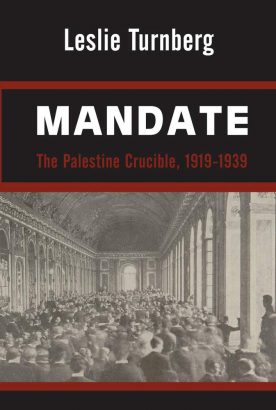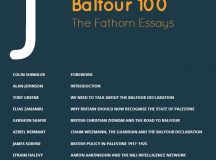Three years ago, a retired British army officer, Ian Westerman, wrote an article in Ha’aretz, entitled ‘What did the British ever do for Israel?’ This piece, courageously suggested that in an age of decolonising the academic syllabus and retrospectively rectifying the perceived wrongs of history, that the British Mandate was overall a positive episode and helped to bring about the state of Israel in 1948. The professional breast beaters duly expressed their faux outrage with comments underneath the article.
Leslie Turnberg, a member of the House of Lords and a distinguished medical academic, has written a book for a general audience, Mandate: The Palestine Crucible 1919-1939 (Vallentine Mitchell 2021) in which he essentially expands on Westerman’s approach. What is remarkable is that the British persevered, albeit begrudgingly, in supporting the Zionists throughout the entire inter-war period.
World War I ended in 1918 with three quarters of a million British dead, a raging flu pandemic and a litany of ambiguous promises. Sherif Hussein bin Ali of Mecca was promised a Hashemite state by Sir Henry McMahon while Chaim Weizmann was the chief architect and recipient of the Balfour Declaration. At the same time, behind closed doors, Sir Mark Sykes and François Georges-Picot gleefully laid the foundations for the division of the decaying Ottoman empire between the British and the French — unbeknown to both Hussein and Weizmann.
It was this tangle of promises, made in order to secure allies to win the war, that so many actors in this drama have castigated Britain as ‘Perfidious Albion’. Britain subsequently attempted to row back and reinterpret these promises, yet it still erected a protective umbrella over Zionist efforts to develop the land. Between 1919 and 1938, the Jewish population increased by 342,000 — but the Arab population increased by 461,000.
The British wanted to maintain control over the Suez Canal. Palestine was seen as the strategic bridge to India. Yet the fall of the great empires during World War I had inspired national liberation movements to fight for independence. For the British, there was violence in Ireland and rumblings in India. In Palestine, it was even more confusing, there were two national movements each fighting over the same territory.
The interwar years were peppered by coercive population exchanges between Greece and Turkey, Japan’s designs on China, the rise of Stalinist Russia, Mussolini’s drive to create a new Roman empire — and the ascendency of an Austrian corporal, a down-and-out in a previous life, to the German Chancellorship, his exploitation of grievances over the Versailles Treaty and a demonic desire to murder Jews. John Maynard Keynes questioned the financial punishment meted out to Germany at Versailles and characterised the new Poland as ‘an economic impossibility with no industry but Jew-baiting’.
As the author notes, the very idea of a Hebrew republic arising during this period of history was an impossibility, against all the odds.
The British were no doubt imbued with a sense of imperial self-importance as the guardian of the Holy Land, but also inherited the tolerance of British Protestantism, the biblical romanticism of the Victorians and a subterranean anti-Semitism. The Jews did not fit into the stereotype of colonised peoples. They answered back and their broad intellectualism jarred with British paternalism and bonhomie. Significantly Israel did not join the British Commonwealth in 1948.
Leslie Turnberg recalls that George Adam Smith’s Atlas of the Historical Geography of the Holy Land (1894) was consulted to define the borders of Palestine. ‘From Dan to Beersheba’ was the blueprint, mentioned in the Book of Judges, the First and Second Books of Samuel, the First and Second Books of Kings. But where was ‘Dan’? The powers-that-be even called in the archaeologists. Yet there are different borders of ancient Israel which are cited in the Hebrew Bible, according to different periods of Israelite history. The author asks where was the northern border — was it up to the Litani River now in Lebanon? Was Mount Hermon to be included? How did Sinai relate to the southern border? Ironically, the first Zionist map in late 1918 was based on the availability of accessible resources and the practicalities of life rather than reference to biblical boundaries.
The Cairo conference of March 1921 bent such thoughts towards the immediate demands of imperial politics. King Faisal, ousted by the French from Damascus, was installed at the ruler of a makeshift patchwork of peoples in an area to be called Iraq. Local nationalists such as Sayyid Talib were exiled by the British to locations such as Ceylon (Sri Lanka) to make way for Faisal. His brother, Abdullah, was additionally mollified by the first partition of Palestine to become Emir of TransJordan.
The author provides interesting statistics that Western Palestine, where the Jews were concentrated, accounted for 8,000 sq. miles whereas Eastern Palestine, now the domain of the Hashemites, accounted for 38,000 sq. miles. He adds that ‘the Jewish home in Palestine’ at the time of this first partition was the size of Wales, but nearly 30 years later at the time of the second partition, it had shrunk to the size of Norfolk.
Churchill told the House of Commons at the time that everything was fundamentally hunky-dory in the Middle East and much money would be saved. The author contends that his speech was ‘a masterpiece of obfuscation and half-lies’.
The British Mandate for Palestine was endorsed by the Council of the League of Nations in July 1922. It actually went beyond the wording of the Balfour Declaration in that it recognised the historical connection of the Jews to Palestine and understood that Zionism meant reconstituting their national home. After all, ‘His Majesty’s Government’ only viewed ‘with favour’ the prospect of a national home for the Jews in Palestine in November 1917 — the Balfour Declaration was not binding. And ‘a home’ was neither a homeland nor a state. What was favourable in 1917 was deemed unfavourable in 1939 when the British needed the Arab world — and their oil reserves — far more as the war clouds gathered in Europe. So the British caveated its support for Jewish immigration from it must only happen ‘under suitable conditions’ into ‘lands not used for public purposes’.
Under the High Commissioner, Sir Herbert Samuel, the building-up of the land brought calm and indeed a modicum of prosperity. Only 500 troops, a squadron of aircraft and a company of armoured cars were needed in Palestine. The French required 30,000 men to keep order in Syria. Even so, the Tarpat disturbances of 1929 which resulted in the killing of Jews in Jerusalem, Hebron and Safad indicated that the calm was transient and that there were clearly insufficient security personnel in Palestine.
Faisal regarded Palestine as an unimportant backwater which the Jews could happily inhabit while Balfour believed that the Arab world would not ‘begrudge this small notch of land’ to the Jews. As history records, the forces of nationalism proved much stronger — as they did after the fall of the USSR in 1991.
The British however became increasingly worried about the revolutionary tendencies of the members of the third aliyah after 1919. They came to Palestine, radiating the wonders of the October Revolution of 1917. The British regarded these Zionists as ‘Bolsheviks’ which certainly helped Lord Sydenham back in the House of Lords to spread the fear of Judeo-Bolshevism, later much appreciated by European fascists. Sydenham, a former governor of Victoria in Australia and Madras in India, became a fellow traveller with nascent fascism and rising anti-Semitism.
One event which alarmed the British was the clash between the Marxist Ahdut Ha’Avoda and the Communist Mopsim on May Day 1921 — and not between ‘hard Left Zionists’ and centre Zionists as the author asserts.
It was also probably a mistake by the author to juxtapose Jabotinsky with the Mufti of Jerusalem. It would have been better to contrast Jabotinsky with Ben-Gurion and the Mufti with the Islamist, Izz ad-Din al-Qassam, killed by the British in 1935 and today an inspiring figure for Hamas. Moreover the identification of Jabotinsky with the Irgun and its leadership during the 1930s is misplaced. He actually attempted to restrain them and frowned upon those of his acolytes in Betar who wished to join the organisation.
The British clearly viewed Palestine as a pawn in the game of imperial rivalry with France. They appreciated the idealism of the Zionist pioneers and perhaps were willingly seduced into the idea that they were earning a place in Jewish and indeed in world history. Yet much of this wooing must be due to the diplomatic charms of the anglophile, Chaim Weizmann who cultivated Balfour, Lloyd-George and Churchill.
This is clearly a labour of love for Leslie Turnberg and the book provides a good introduction to the complexities of the Israel-Palestine question in the Middle East during the inter-war period. He rightly asks the question of whether, despite all the drawbacks and flaws in British policy, Israel would have come into existence without the guidance of the mandarins of Whitehall and their political masters. Leslie Turnberg has addressed this problem and rebalanced our understanding of this complex and difficult period.





































